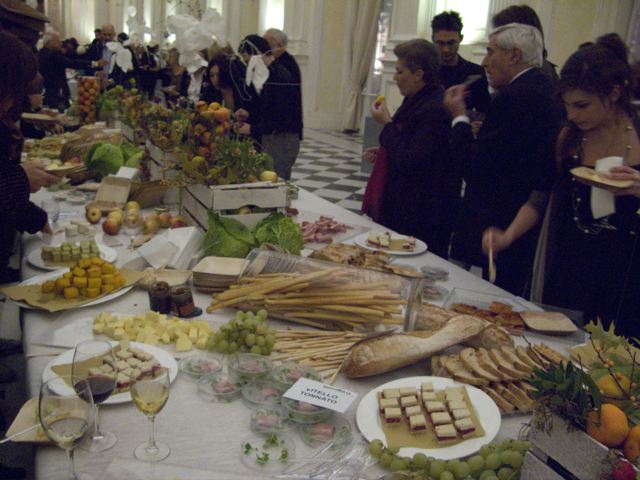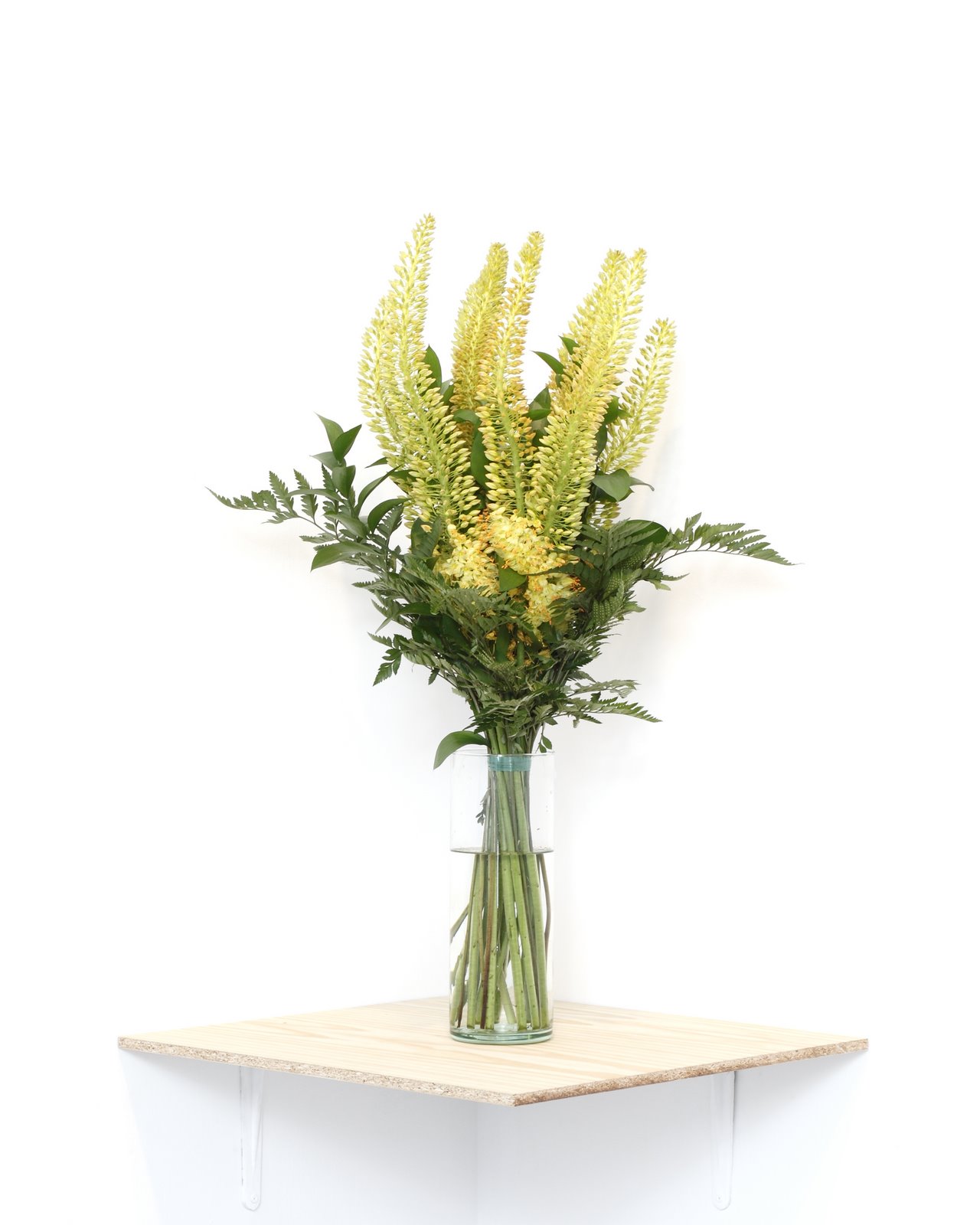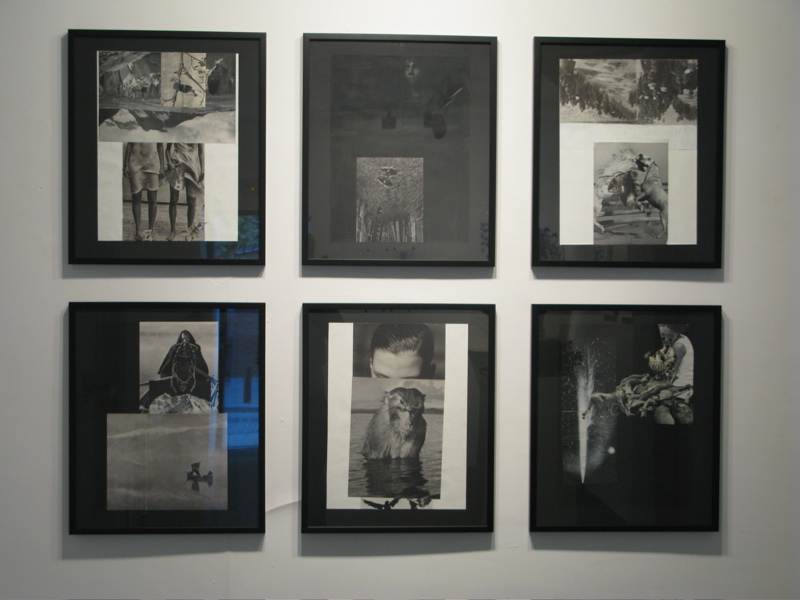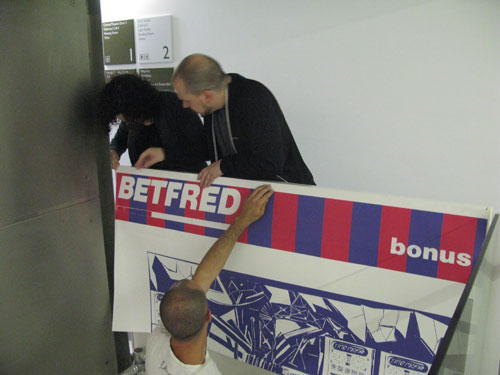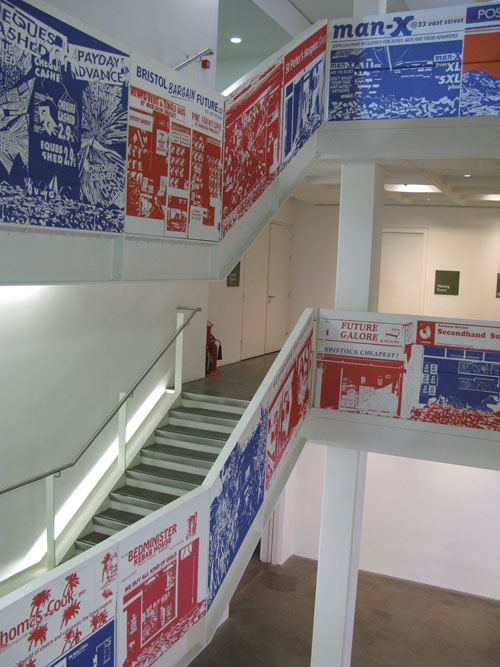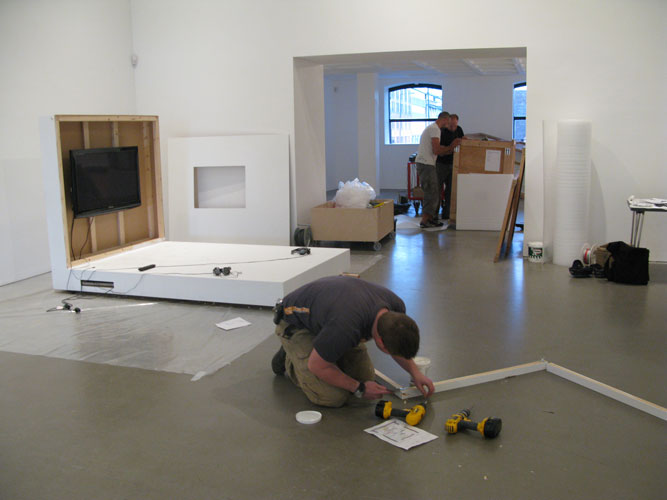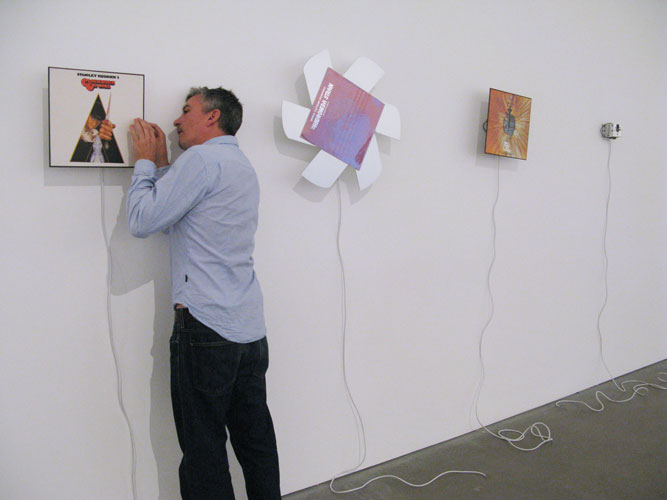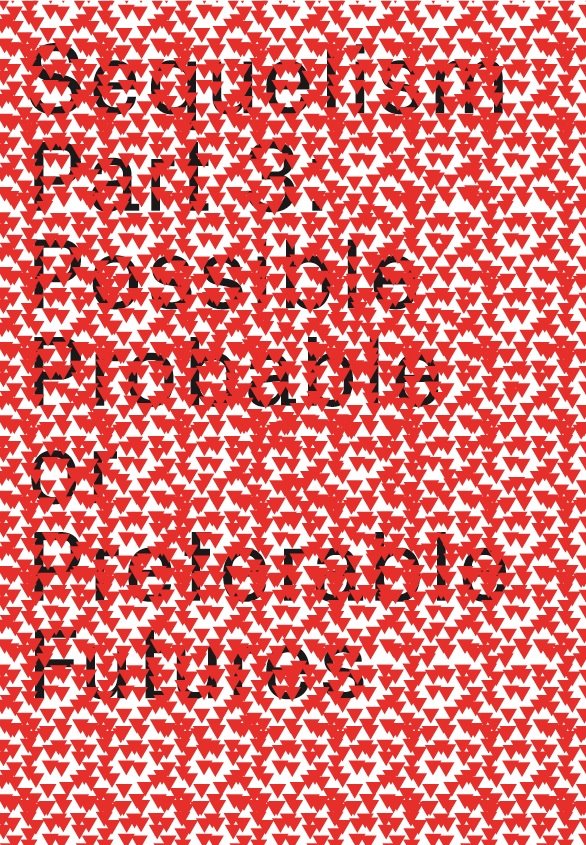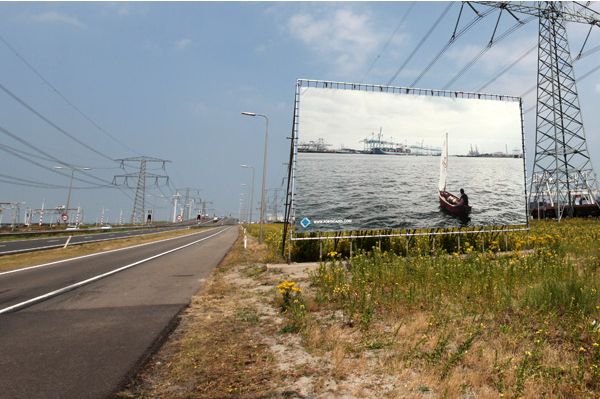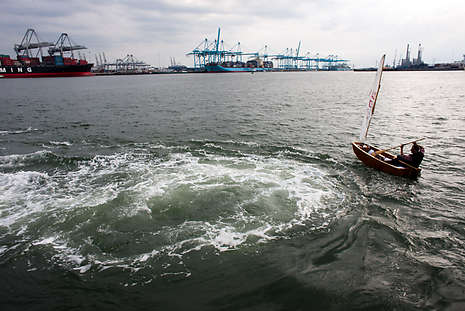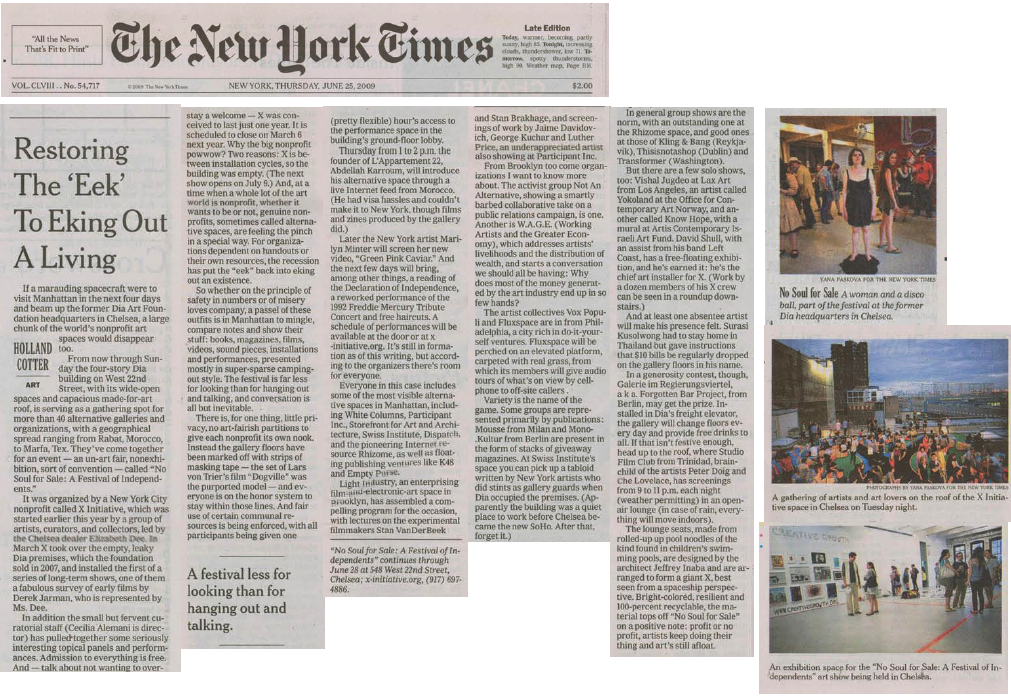Latitudes' "out of office" photo album 2008-9
Thu, Jul 30 2009As the 2008–9 artistic cycle turns for many towards a holiday exodus and 'out of office' autoresponders, below is a selection of some unseen and 'behind the scenes' moments from our projects since last summer.
A big thank you to everyone involved in our 2008-9 projects y felices vacaciones!
– Latitudes
(Three images above): Mariana with Lawrence Weiner during the installation of Lawrence Weiner's exhibition 'THE CREST OF A WAVE' at the Fundació Suñol, Barcelona, in October–November 2008; during the press conference; Lawrence, Latitudes and Fundació Suñol team (Sergi Aguilar, Maga Ruiz, Xavier De Luca, Mireia Arnau and Jaume Brunet) photographed by Pierre-Jean Moulis after tossing a horseshoe upon the crest of a wave.
 16–19 October 2008: presentation of the Danish artist Tue Greenfort 'transparent' bins outside Frieze Art Fair, London, commissioned by the Royal Society of Arts' 'Arts & Ecology' programme.
16–19 October 2008: presentation of the Danish artist Tue Greenfort 'transparent' bins outside Frieze Art Fair, London, commissioned by the Royal Society of Arts' 'Arts & Ecology' programme.
5–9 November 2008: Leaving the 'X, Y, etc!' Videolounge in Artissima Art Fair, Torino, Italy; admiring the phenomenal long table arrangement Artissima dinner hosted at the equally phenomenal Venaria Reale.


 November 2008: fourth visit to Rotterdam – evening boat trip with some of 'Portscapes' artists, site visit to the port with the Port of Rotterdam's Sjaak Poppe (Hans Schabus and Roman Keller alongside) and discussions in Marjolijn Dijkman's studio (Roman Keller and Christina Hemauer – with Ilana Halperin on Skype)
November 2008: fourth visit to Rotterdam – evening boat trip with some of 'Portscapes' artists, site visit to the port with the Port of Rotterdam's Sjaak Poppe (Hans Schabus and Roman Keller alongside) and discussions in Marjolijn Dijkman's studio (Roman Keller and Christina Hemauer – with Ilana Halperin on Skype)

 November 2008: ‘La, la, la, la: on winning and losing’ co-curator Aimar Arriola arranging a work with artist Verónica Aguilera and (below) selecting images with Fermín Jimenez Landa and Oriol Vilanova.
November 2008: ‘La, la, la, la: on winning and losing’ co-curator Aimar Arriola arranging a work with artist Verónica Aguilera and (below) selecting images with Fermín Jimenez Landa and Oriol Vilanova.
8 February 2009: SKOR curator Theo Tegelaers and Jan Dibbets during the filming of Jan Dibbets' '6 Hours Tide Object with Correction of Perspective'; some of 'Portscapes' artists including Bik Van der Pol and Marjolijn Dijkman visit the beach while waiting for the tide to go up; Christiane Bosman (SKOR press coordinator) and curator Theo Tegelaers from SKOR at 'Portscapes' during Art Rotterdam opening evening.
18 February 2009: Vena (por la) talk with (the then) Walker Art Center associate curator Doryun Chong (now Associate Curator at MoMA in New York).
April 2009: The Associació d'Art Crítics de Catalunya awards Fundació Suñol for their exhibition programme (Latitudes-curated projects Lawrence Weiner's 'THE CREST OF THE WAVE' and the Land Art film programme 'A Stake in the Mud, A Hole in the Reel. Land Art's Expanded Field, 1968–2008' were part of this season).

 (7 images above): First Neapolitan lunch with Simon Fujiwara and Jordi Mitjà on May 8, 2009: deep-fried maccheroni; Erick Beltrán installing during 'Provenances', Umberto di Marino, Naples; preparing Simon's 'Museum of incest'; subtitling session with Nicoletta Daldanise; delightful Sicilian cuisine at Umberto's house, documenting Erick's work during the opening night and audience during Simon's performance 'The Museum of Incest: A Guided Tour' (publication here).
(7 images above): First Neapolitan lunch with Simon Fujiwara and Jordi Mitjà on May 8, 2009: deep-fried maccheroni; Erick Beltrán installing during 'Provenances', Umberto di Marino, Naples; preparing Simon's 'Museum of incest'; subtitling session with Nicoletta Daldanise; delightful Sicilian cuisine at Umberto's house, documenting Erick's work during the opening night and audience during Simon's performance 'The Museum of Incest: A Guided Tour' (publication here).
(3 Above): During the installation of 'The Garden of Forking Paths', Maisterravalbuena, Madrid, May 2009; installation instructions for Rosalind Nashashibi & Lucy Skaer's photographic pieces and post-opening beer landscape at Maisterravalbuena office, 29 May 2009.
15 June 2009: Hans Schabus, Port of Rotterdam team and curators mulling over the location options for Hans's photo shoot of his 'Portscapes' project 'Europahaven, Port of Rotterdam, 17 Juni 2009'.
24–28 June 2009 (2 above): At our temporary office during the non-profit festival 'No Soul for Sale', in New York [Note Michael Jackson's 'breaking news' on screen!].
The Bruce High Quality Foundation in full (we are indebted to them for their fantastic 1983 Burger King set up)
(3 above) Installing Graham Gussin work during 'Sequelism Part 3. Possible, Probable or Preferable futures' in Arnolfini, Bristol (July 2009); hanging around with participating artists Francesc Ruiz and Haegue Yang as well as Nav Haq (Arnolfini curator) before dinner; and knitting lessons from Haegue at Arnolfini's bar.
[All photos: Latitudes | www.lttds.org]
Fundació Suñol, hans schabus, Ignasi Aballí, Jan Dibbets, Lawrence Weiner, Maisterravalbuena, out of office, Portscapes, Sequelism, Simon Fujiwara, SKOR, Tue Greenfort, Umberto di Marino, X initiative
A big thank you to everyone involved in our 2008-9 projects y felices vacaciones!
– Latitudes
(Three images above): Mariana with Lawrence Weiner during the installation of Lawrence Weiner's exhibition 'THE CREST OF A WAVE' at the Fundació Suñol, Barcelona, in October–November 2008; during the press conference; Lawrence, Latitudes and Fundació Suñol team (Sergi Aguilar, Maga Ruiz, Xavier De Luca, Mireia Arnau and Jaume Brunet) photographed by Pierre-Jean Moulis after tossing a horseshoe upon the crest of a wave.
 16–19 October 2008: presentation of the Danish artist Tue Greenfort 'transparent' bins outside Frieze Art Fair, London, commissioned by the Royal Society of Arts' 'Arts & Ecology' programme.
16–19 October 2008: presentation of the Danish artist Tue Greenfort 'transparent' bins outside Frieze Art Fair, London, commissioned by the Royal Society of Arts' 'Arts & Ecology' programme.5–9 November 2008: Leaving the 'X, Y, etc!' Videolounge in Artissima Art Fair, Torino, Italy; admiring the phenomenal long table arrangement Artissima dinner hosted at the equally phenomenal Venaria Reale.


 November 2008: fourth visit to Rotterdam – evening boat trip with some of 'Portscapes' artists, site visit to the port with the Port of Rotterdam's Sjaak Poppe (Hans Schabus and Roman Keller alongside) and discussions in Marjolijn Dijkman's studio (Roman Keller and Christina Hemauer – with Ilana Halperin on Skype)
November 2008: fourth visit to Rotterdam – evening boat trip with some of 'Portscapes' artists, site visit to the port with the Port of Rotterdam's Sjaak Poppe (Hans Schabus and Roman Keller alongside) and discussions in Marjolijn Dijkman's studio (Roman Keller and Christina Hemauer – with Ilana Halperin on Skype)
 November 2008: ‘La, la, la, la: on winning and losing’ co-curator Aimar Arriola arranging a work with artist Verónica Aguilera and (below) selecting images with Fermín Jimenez Landa and Oriol Vilanova.
November 2008: ‘La, la, la, la: on winning and losing’ co-curator Aimar Arriola arranging a work with artist Verónica Aguilera and (below) selecting images with Fermín Jimenez Landa and Oriol Vilanova.8 February 2009: SKOR curator Theo Tegelaers and Jan Dibbets during the filming of Jan Dibbets' '6 Hours Tide Object with Correction of Perspective'; some of 'Portscapes' artists including Bik Van der Pol and Marjolijn Dijkman visit the beach while waiting for the tide to go up; Christiane Bosman (SKOR press coordinator) and curator Theo Tegelaers from SKOR at 'Portscapes' during Art Rotterdam opening evening.
18 February 2009: Vena (por la) talk with (the then) Walker Art Center associate curator Doryun Chong (now Associate Curator at MoMA in New York).
April 2009: The Associació d'Art Crítics de Catalunya awards Fundació Suñol for their exhibition programme (Latitudes-curated projects Lawrence Weiner's 'THE CREST OF THE WAVE' and the Land Art film programme 'A Stake in the Mud, A Hole in the Reel. Land Art's Expanded Field, 1968–2008' were part of this season).

 (7 images above): First Neapolitan lunch with Simon Fujiwara and Jordi Mitjà on May 8, 2009: deep-fried maccheroni; Erick Beltrán installing during 'Provenances', Umberto di Marino, Naples; preparing Simon's 'Museum of incest'; subtitling session with Nicoletta Daldanise; delightful Sicilian cuisine at Umberto's house, documenting Erick's work during the opening night and audience during Simon's performance 'The Museum of Incest: A Guided Tour' (publication here).
(7 images above): First Neapolitan lunch with Simon Fujiwara and Jordi Mitjà on May 8, 2009: deep-fried maccheroni; Erick Beltrán installing during 'Provenances', Umberto di Marino, Naples; preparing Simon's 'Museum of incest'; subtitling session with Nicoletta Daldanise; delightful Sicilian cuisine at Umberto's house, documenting Erick's work during the opening night and audience during Simon's performance 'The Museum of Incest: A Guided Tour' (publication here).
(5 above): Arrival day in Beijing on May 18, 2009, with Ignasi Aballí; laying out the Barcelona posters for 'Scenic viewpoints'; (around 3.30am...) installation of 'Nothing, or Something' at Yintai Centre with Suitcase Art Projects artistic director Carol Yinghua Lu and Ignasi; checking the vinyl is straight with Ignasi ('El País' always at hand) and a quiet conversation with Carol on the escalators.
15 June 2009: Hans Schabus, Port of Rotterdam team and curators mulling over the location options for Hans's photo shoot of his 'Portscapes' project 'Europahaven, Port of Rotterdam, 17 Juni 2009'.
24–28 June 2009 (2 above): At our temporary office during the non-profit festival 'No Soul for Sale', in New York [Note Michael Jackson's 'breaking news' on screen!].
The Bruce High Quality Foundation in full (we are indebted to them for their fantastic 1983 Burger King set up)
(3 above) Installing Graham Gussin work during 'Sequelism Part 3. Possible, Probable or Preferable futures' in Arnolfini, Bristol (July 2009); hanging around with participating artists Francesc Ruiz and Haegue Yang as well as Nav Haq (Arnolfini curator) before dinner; and knitting lessons from Haegue at Arnolfini's bar.
[All photos: Latitudes | www.lttds.org]
Installation shots of 'Sequelism...', Arnolfini, Bristol on Latitudes' website
Tue, Jul 21 2009Francesc Ruiz 'Untitled' (Bristol) 2009. Photos: Latitudes | www.lttds.org
We have uploaded a slideshow with installation shots (CLICK HERE) of the recently inaugurated exhibition 'Sequelism Part 3: Possible, Probable, or Preferable Futures' on view at Arnolfini, Bristol until 20 September 2009.
'Sequelism, Part 3: Possible, Probable or Preferable Futures' is an exhibition project that looks into the future and at that which is yet to happen. It considers how the inexact arena of futurology is used as a means to better comprehend the present and the past.
'Sequelism Part 3' includes works by Mariana Castillo Deball (1975, Mexico City. Lives in Berlin/Amsterdam), Heman Chong (1977, Malaysia. Lives in Berlin/Singapore), Graham Gussin (1960, London. Lives in London), Victor Man (1974, Cluj–Napoca. Lives in Cluj–Napoca), Francesc Ruiz (in residency) (1971 Barcelona. Lives in Barcelona/Berlin), Jordan Wolfson (1980, New York. Lives New York/Berlin) and Haegue Yang (1971 Seoul. Lives in Berlin/Seoul).
Haegue Yang, 'Holiday for Tomorrow', 2007. Photos: Latitudes | www.lttds.org
Taking the style of a magical realist tale or children's story, Mariana Castillo Deball's 'Nobody Was Tomorrow' (2007) consists of three interconnected stories based on the fictional connections between three real ‘characters’ – ‘Nobody’ a defunct accelerating aging machine, a sprawling fig tree and the remains of a Roman bath in Čačak, Serbia. Castillo Deball makes us mindful of culture’s fortunes through a swirling fable about the sedimentation of time, encapsulated by an image of a damaged book.
'Index (Down)' (2009) is part of Heman Chong's ongoing series ‘Surfacing’, which requires the action of putting up 3000 stickers on a wall within a given set of instructions. The red triangular stickers are intended to resemble the downward pointing arrows used to denote a fall in value of stock exchanges. Considering the paranoia around the scenario of economic freefall, Index (Down) uses this motif to create an abstract pattern evoking a waterfall.
Graham Gussin's 'Hypnotic/Dystopic/Optic' (2009) presents a ‘horizon line’ of rotating record covers for soundtracks to renowned dystopian science fiction films. The covers are set to rotate at the speed at which their images ‘vaporise’ at the limit of visual comprehension. 'In The Not Too Distant Future (Self Portrait with Sleeping Masks)' (2009) is a self-portrait of the artist inspired by a scene from the film La Jetée (1962) concerning an experiment in time travel following a nuclear war.
Francesc Ruiz's stair barriers installation 'Untitled (Bristol)' (2009) takes the shop windows of the high streets in the south of Bristol – East Street and North Street – as sequential units akin to comic-book vignettes. Ruiz has created a narrative around a dystopian future in which destruction, revolt, and anger have invaded the city after an economic downturn.
Jordan Wolfson 'Untitled' (2007) centres on a 1984 Macintosh 128k, the first affordable home computer to use a mouse-driven graphical user interface. The computer is seen stranded by the side of a road in Connecticut, built in the late 1930s following the Great Depression. The soundtrack comprises a triumphalist monologue concerning the emergence of American abstract painting in the 1950s. Wolfson is interested in obsolescence and in these elements as generational touchstones.
Victor Man's three pieces could be read in terms of premonition and symbolic rites which relate to the uncertainty of the future in a similar way that memory relates to the past. A taxidermy fox head is wedged within a metal structure as if a votive or magical offering. Vinyl text on a wall is negated by a neon ‘X’. A ceramic funerary plate bears the image of stars, whose arrangement has often been interpreted by man in terms of fate and fortune.
Haegue Yang's 'Holiday for Tomorrow' (2007) considers our perception of time, and the emotional anticipation of holidays, those socially-agreed days in which labour is suspended and we attempt to rest our bodies and minds. At its centre is a video essay showing Seoul during the Korean harvest holiday Chuseok over which a female voice reflects on the postponement of desire and the dysfunctional hopes triggered by enforced leisure.
Accompanying events and film programme here.
Exhibition curated by Nav Haq (Curator, Arnolfini) and Latitudes.
Supported by the State Corporation for Spanish Cultural Action Abroad (SEACEX), the Direction of Cultural and Scientific Relations of the Spanish Ministry of Foreign Affairs, Institut Ramon Llull, IFA, National Arts Council, Singapore and The Ratiu Family Foundation.
'El jardín de senderos que se bifurcan' prorrogada hasta 31 Julio | 'The Garden of Forking Paths' exhibition extended until 31 July
Mon, Jul 20 2009
Installation view of 'CMYK Floral' (2007) by Leslie Hewitt y Matt Keegan. Courtesy of the artists.
| UK |
| UK |
The exhibition 'The Garden of Forking Paths' at Maisterravalbuena, Madrid, has been extended until the Friday 31 July.
'The Garden of Forking Paths' brings together the work of five artist-duos to consider duality, simultaneity, saturation and proliferation. Eric Bell & Kristoffer Frick present two works ('Untitled' (2007) and 'The pleasure of moving from place to place' (2008)) which affirm the fundamentally illusory nature of photography. ‘The Infinite Library’ (2007–ongoing), two books from which are presented here, is an expanding, seemingly arbitrary archive by Daniel Gustav Cramer & Haris Epaminonda inspired in part by the writings of Borges. huber.huber’s monochromatic series ‘dark grounds’ (2007-8) juxtaposes photojournalism and wildlife studies replicate the dislocation so crucial to Surrealism while offering a portentous and uncertain wilderness. Leslie Hewitt & Matt Keegan’s 'CMYK Floral' (2007) consists of the presentation of weekly monochromatic flower arrangements, corresponding in sequence with the inks used in four colour printing. Nashashibi/Skaer present eighteen photographs from the installation 'Pygmalion Workshop' (2008) inspired by the myth of Pygmalion in which he sculpts an ivory figure which is brought to life by Aphrodite to become his lover.
| ES |
La exposición 'El jardín de senderos que se bifurcan' en Maisterravalbuena, Madrid, se ha prorrogado hasta el viernes 31 Julio. 'El jardín de senderos que se bifurcan' reúne la obra de cinco parejas de artistas y reflexiona sobre la dualidad, la simultaneidad, la saturación y la proliferación.
Eric Bell & Kristoffer Frick presentan dos obras ['Untitled' (2007) y 'The pleasure of moving from place to place' (2008)] que afirman la fundamentalmente ilusoria naturaleza de la fotografía. 'The Infinite Library' (2007–en curso), cuyos dos libros que se presentan aquí, es un archivo aparentemente arbitrario en expansión de Daniel Gustav Cramer y Haris Epaminonda, inspirado en parte por los escritos de Borges. La selección monocromática 'dark grounds' (2007–8) de huber.huber yuxtapone imágenes de periodismo fotográfico y estudios de la vida silvestre replicando la técnica de dislocación tan crucial para el Surrealismo. 'CMYK Floral' (2007) de Leslie Hewitt y Matt Keegan consiste en la presentación semanal de un arreglo floral monocromático, correspondiendo con la secuencia de colores utilizados en la impresión a cuatro colores – cian, magenta, amarillo y negro. Nashashibi / Skaer presentan dieciocho fotografías de la instalación 'Pygmalion Workshop' (2008) inspiradas en el mito de Pigmalión, quien se enamoró de la figura de marfil que él mismo esculpió y a la que consecuentemente Afrodita dio la vida convirtiéndose en su amante.
–
Doctor Fourquet 1
28012 Madrid, SPAIN
Opening: Mon-Fri 10-14;15.30-19.30; Sat 10-18pm
Sequelism Part 3... images of the installation in progress
Wed, Jul 15 2009Notas presentación de Latitudes expuestas durante las "Jornadas internacionales de debate para El Canòdrom, el nuevo Centro de Arte en Barcelona", 6–7 Julio 2009
Fri, Jul 10 2009
In reference to "Artists should be at the centre of the centre, at every step and in all aspects." Nordic and Danish Pavilion Press Conference seating set up, Venice Biennale 2009. Photo: Latitudes | www.lttds.org
Notas de la presentación de Latitudes (en español e inglés)
'Jornadas internacionales de debate para un nuevo Centro de Arte en Barcelona'
6–7 Julio 2009
Mesa: 'El Canòdrom, un nuevo equipamiento en Barcelona visto por artistas, críticos y comisarios'.
(Español)
– Anunciar lo antes posible la convocatoria pública para el puesto de dirección. Definir un programa artístico de relevancia local e internacional para el nuevo centro, un centro con personalidad jurídica propia, autónomo e independiente de cambios políticos;
– Elección de un equipo de trabajo (desde técnicos o becarios hasta encargados de producción, seleccionados por sus cualidades profesionales a través de convocatorias públicas y entrevistas personales). Definir conjuntamente un programa artístico, campaña de inauguración, programa de actividades post-inauguración y el uso de los espacios del Canòdrom junto con los arquitectos encargados de la remodelación;
– Conceptualizar una nueva identidad gráfica que respete la fuerte presencia arquitectónica y la historia del edificio – ej. mantener la tipografía, carteles galgos, etc.;
– Programación previa a la inauguración – el Canòdrom debe existir desde ya. Iniciar una presencia mediática local, nacional e internacional. Organizar visitas del edificio para prensa, galeristas, coleccionistas, gente del barrio, etc. pre-inauguración. Dar a conocer el nuevo centro desde dentro y a su programación. Fomentar la transparencia. Crear una nueva audiencia para el Canòdrom, una comunidad – por ej. programación previa a apertura edificio: Bòlit en Girona o el MUSAC en León.
– Programar dentro y fuera del edificio – pensar de modo expansivo e innovador y no limitar la creatividad al espacio de físico del edificio. No olvidar el poder de la web;
– El Canòdrom debe ser un espacio de producción y co-producción (es primordial colaborar con otros centros), experimentación y discusión. Saber tomar riesgos, ser creativo con las posibilidades que ofrece a nivel local e internacional;
– Estimular y nutrir relaciones otros centros de producción local e internacional. Formar parte de un contexto artístico y crear y reforzar la escena cultural;
– Establecer una comisión de expertos / comité asesor independiente (‘Advisory Board’) para dar solidez al programa y estabilidad e independencia a la dirección. El comité ayuda a establecer y a consolidar relaciones con otros centros de igual o similar perfil;
– Crear un equipamiento donde la escena artística se vea representada, donde se cree complicidad con los agentes locales y donde los recursos y facilidades disponibles sean de calidad, con garantías profesionales. Potenciar la profesionalización del sector.
(English)
– Barcelona should be a city that can support its artists within an international context and the new art centre should publicly perform a leading role in this respect. It needs to create a space of dialogue and encounter between Catalan, Spanish and international artists and focus on the active development of practice as well as new audiences.
– In a move symptomatic of and responding to a certain lack of stimulus and critical discussion in the city, the artists Marc Vives, Rubén Grilo, and Alex Reynolds created 'Vena (por la)', an incisive and ongoing series of artist and curator talks which take place in the La Central bookshop. Artists are taking matters into their own hands and starting their own initiatives seemingly because institutions are not providing enough throughput of public talks, or at least not at the most valued level.
– Canòdrom should be an opportunity to link up different constituencies and audiences (from collectors, art students, to graphic designers, galleries, art writers, art historians...)
– One art centre cannot fully substitute for the shortcomings of the Spanish art academy system – what would be the most valuable long-term parallel goal would be to invest in an international post-graduate studio programme on the model of the Stadelschule in Frankfurt or the Rijksakademie in Amsterdam. Canòdrom should nevertheless have a strong element of professional development and advocacy, critical exchange and debate as part of its programme not as a bolted-on education bonus – it needs to be more than an exhibition space.
– Canòdrom should stimulate, support and create professional artists and curators and lead by example. In the same way, one cannot assume the abstract presence of an audience but needs to actively produce different audiences, a new institution needs to take a lead in the actual formation and conditions of stimulus for the work of artists in society. Artists should be at the centre of the centre, at every step and in all aspects.
Latitudes, July 2009.
CONTENIDOS RELACIONADOS:
- Gone with the wind: on the 'art crunch' and the Centre d'Art de Barcelona, the saga continues... 16 December 2008
- Jornadas entorno al Canòdrom, el futuro Centro de Arte en Barcelona, 6–7 Julio 2009 (3 julio 2009)
SAVE THE DATE: Friday 17 July opening of 'Sequelism Part 3. Possible, Probable or Preferable Futures', Arnolfini, Bristol
Mon, Jul 6 2009
Invitation design to the exhibition with work by Heman Chong.
'Sequelism Part 3: Possible, Probable or Preferable Futures' (18 July–20 September 2009)
Preview: Friday 17 July, 6–8pm
Venue: Arnolfini, Bristol, UK
Venue: Arnolfini, Bristol, UK
Artists: Mariana Castillo Deball (1975, Mexico City. Lives in Berlin/Amsterdam), Heman Chong (1977, Malaysia. Lives in Berlin/Singapore), Graham Gussin (1960, London. Lives in London), Victor Man (1974, Cluj–Napoca. Lives in Cluj–Napoca), Francesc Ruiz (in residency) (1971 Barcelona. Lives in Barcelona/Berlin), Jordan Wolfson (1980, New York. Lives New York/Berlin) and Haegue Yang (1971 Seoul. Lives in Berlin/Seoul)
Co-curated by Arnolfini and Latitudes
'Sequelism Part 3: Possible, Probable or Preferable Futures' is a project that looks into the future and at that which is yet to happen. It considers how art and the inexact arena of futurology might be utilised as a means to better comprehend, rethink, obscure, or even colonise the present. Knowledge of current and historical events often plays a role in collective foresight or prognoses of change that is yet to take place. In a similar fashion, futurology could be said to deal with memory in reverse. The project seeks to investigate how prospective visions might be generated for vastly differing reasons, offering great idealism on the one hand, or harnessing political and societal anxiety on the other.
The future is commonly manifested in popular cultural forms, including science fiction, yet how might we look beyond the present without recourse to established genres? To what extent does strategic foresight affect our understanding of the ‘now’ or the ‘when’? Is the future a culturally specific phenomenon that is inherently ‘Western’ in its own gaze and orientation? And just how accurate can we be when imagining the future? The Sequelism project addresses issues and questions such as these. Disputing illustrative organisation around a predetermined thesis, the project itself invites doubt, speculation, and to-be-determined outcomes.
This is the first in a trilogy of Sequelism exhibitions, with Part 2 in 2010.
More information: http://futurologyprogramme.org
Events and screenings
Neil Cummings and Marysia Lewandowska
Museum Futures: Distributed
Screening/Discussion, Saturday 18 July, 2pm, Free
Neil Cummings and Marysia Lewandowska’s film 'Museum Futures: Distributed (2008) is a machinima record of the centenary interview with Moderna Museet’s executive Ayan
Lindquist in June 2058. It explores a possible genealogy for contemporary art practice and its institutions, by reimagining the role of artists, museums, galleries, markets, ‘manufactories’ and academies. The screening will also incorporate a discussion led by Neil Cummings and the curators of the Sequelism exhibition, discussing the future of art institutions.
The Futurological Congress
Sequelism Artists’ Screening Programme
Screening, Friday 21 August, 7.30pm, £3/£2 concs
A programme of artists’ videos selected by the curators of Sequelism to accompany the exhibition, including works by Marjolijn Dijkman, Jordan Wolfson and Julia Meltzer & David
Thorne. Introduced by Nav Haq, Exhibitions Curator, Arnolfini.
David Maljkovic
'Scene for a New Heritage Trilogy Screening'
Thursday 17 September, 6.30pm, Free
The films in David Maljkovic’s renowned 'Scene for a New Heritage Trilogy' (2004–6) are set between 2045 and 2071, visualising different encounters with a communist monument at the memorial park at Petrova Gora, Croatia, and speculating on how the meanings of history and monuments change over time.
Roy Ascott
Art and Technoetic Evolution: when the Mind outgrows the Body
Artist’s talk, Saturday 19 September, 2pm, Free
Artist and theorist Roy Ascott gives a presentation on the recent ideas informing his Technoetics art practice, that has grown out of his long-term research into cybernetic and ‘telematic’ art.
Will Holder
Neologisms Workshop
Workshop, September, date TBC, Free
Booking required, call 0117 917 2300 / 01
A language workshop for young people led by the designer, writer, and editor Will Holder for constructing brand new words or ‘neologisms’, inspired by R. Buckminster Fuller’s technique for synthesizing existing words to generate names for new concepts and designs.
–
Arnolfini
16 Narrow Quay
Bristol BS1 4QA, UK
www.arnolfini.org.uk
Opens: 10am-6pm Tues-Sun & Bank Holiday Mondays | Closed Mondays | Free entrance
Sequelism is possible thanks to the generous support of the State Corporations for Spanish Cultural Action Abroad (SEACEX), the Direction of Cultural and Scientific Relations of the Spanish Ministry of Foreign Affairs, Institute Ramon Llull, The National Arts Council Singapore and IFA.
Co-curated by Arnolfini and Latitudes
'Sequelism Part 3: Possible, Probable or Preferable Futures' is a project that looks into the future and at that which is yet to happen. It considers how art and the inexact arena of futurology might be utilised as a means to better comprehend, rethink, obscure, or even colonise the present. Knowledge of current and historical events often plays a role in collective foresight or prognoses of change that is yet to take place. In a similar fashion, futurology could be said to deal with memory in reverse. The project seeks to investigate how prospective visions might be generated for vastly differing reasons, offering great idealism on the one hand, or harnessing political and societal anxiety on the other.
The future is commonly manifested in popular cultural forms, including science fiction, yet how might we look beyond the present without recourse to established genres? To what extent does strategic foresight affect our understanding of the ‘now’ or the ‘when’? Is the future a culturally specific phenomenon that is inherently ‘Western’ in its own gaze and orientation? And just how accurate can we be when imagining the future? The Sequelism project addresses issues and questions such as these. Disputing illustrative organisation around a predetermined thesis, the project itself invites doubt, speculation, and to-be-determined outcomes.
This is the first in a trilogy of Sequelism exhibitions, with Part 2 in 2010.
More information: http://futurologyprogramme.org
Events and screenings
Neil Cummings and Marysia Lewandowska
Museum Futures: Distributed
Screening/Discussion, Saturday 18 July, 2pm, Free
Neil Cummings and Marysia Lewandowska’s film 'Museum Futures: Distributed (2008) is a machinima record of the centenary interview with Moderna Museet’s executive Ayan
Lindquist in June 2058. It explores a possible genealogy for contemporary art practice and its institutions, by reimagining the role of artists, museums, galleries, markets, ‘manufactories’ and academies. The screening will also incorporate a discussion led by Neil Cummings and the curators of the Sequelism exhibition, discussing the future of art institutions.
The Futurological Congress
Sequelism Artists’ Screening Programme
Screening, Friday 21 August, 7.30pm, £3/£2 concs
A programme of artists’ videos selected by the curators of Sequelism to accompany the exhibition, including works by Marjolijn Dijkman, Jordan Wolfson and Julia Meltzer & David
Thorne. Introduced by Nav Haq, Exhibitions Curator, Arnolfini.
David Maljkovic
'Scene for a New Heritage Trilogy Screening'
Thursday 17 September, 6.30pm, Free
The films in David Maljkovic’s renowned 'Scene for a New Heritage Trilogy' (2004–6) are set between 2045 and 2071, visualising different encounters with a communist monument at the memorial park at Petrova Gora, Croatia, and speculating on how the meanings of history and monuments change over time.
Roy Ascott
Art and Technoetic Evolution: when the Mind outgrows the Body
Artist’s talk, Saturday 19 September, 2pm, Free
Artist and theorist Roy Ascott gives a presentation on the recent ideas informing his Technoetics art practice, that has grown out of his long-term research into cybernetic and ‘telematic’ art.
Will Holder
Neologisms Workshop
Workshop, September, date TBC, Free
Booking required, call 0117 917 2300 / 01
A language workshop for young people led by the designer, writer, and editor Will Holder for constructing brand new words or ‘neologisms’, inspired by R. Buckminster Fuller’s technique for synthesizing existing words to generate names for new concepts and designs.
–
Arnolfini
16 Narrow Quay
Bristol BS1 4QA, UK
www.arnolfini.org.uk
Opens: 10am-6pm Tues-Sun & Bank Holiday Mondays | Closed Mondays | Free entrance
Sequelism is possible thanks to the generous support of the State Corporations for Spanish Cultural Action Abroad (SEACEX), the Direction of Cultural and Scientific Relations of the Spanish Ministry of Foreign Affairs, Institute Ramon Llull, The National Arts Council Singapore and IFA.
Newsletter #14, July 2009
Fri, Jul 3 2009We have just circulated our newsletter #14 (read English version or Versión española).
In July we are presenting Hans Schabus' 'Europahaven, Rotterdam, 17 Juni 2009' (see above) at the visitor centre Futureland (until 15 August) and concluded the screenings of Jan Dibbets' film '6 Hours Tide Object with Correction of Perspective', which will soon be available on Portscapes' website (www.portscapes.com).
We are also curating the group exhibition 'Sequelism. Part 3: Possible, Probable, or Preferable Futures', Arnolfini, Bristol, UK, opening 17 July (remains on view until 20 September). Part 3 includes works by Mariana Castillo Deball (1975, Mexico City. Lives in Berlin/Amsterdam), Heman Chong (1977, Malaysia. Lives in Berlin/Singapore), Graham Gussin (1960, London. Lives in London), Victor Man (1974, Cluj–Napoca. Lives in Cluj–Napoca), Francesc Ruiz (in residency) (1971 Barcelona. Lives in Barcelona/Berlin), Jordan Wolfson (1980, New York. Lives New York/Berlin) and Haegue Yang (1971 Seoul. Lives in Berlin/Seoul). Read more about the events programme here.
We also published installation images and press links related to Latitudes' recent participation in the festival of independent and non-profit art organisations 'NO SOUL FOR SALE – A Festival of Independents' organised by X initiative in New York (24–28 June 2009) where we had an office ‘scenario’ conceived by the artist group The Bruce High Quality Foundation, incorporating dining furniture from the abandoned 1983 Burger King from Governors Island.
This month is the last chance to visit the exhibitions 'The Garden of Forking Paths' (Maisterravalbuena, Madrid, until 18th July, images here) and 'Nothing, or Something' (a new project by Ignasi Aballí for Suitcase Art Projects, Beijing, China, until 22nd July, images here).
If you would like to subscribe to our mailing list please fill your data on this contact form (see left) and choose one language. If you would like to read previous newsletters or annoucements, click here.
You can also join us on facebook.
Hans Schabus project for 'Portscapes': 'Europahaven, Port of Rotterdam, 17 Juni 2009'
Fri, Jul 3 2009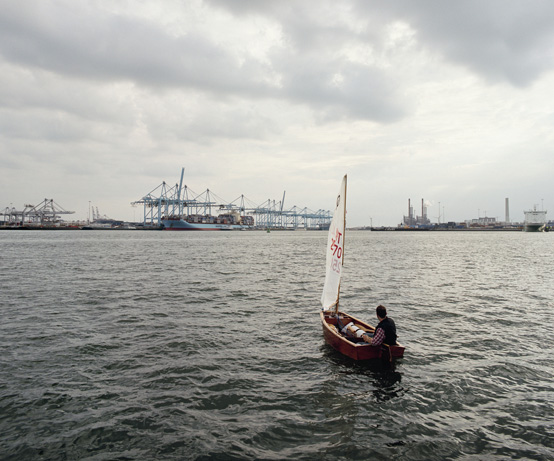 |
| Hans Schabus, 'Europahaven, Rotterdam, 17 Juni 2009' produced in the context of Portscapes commission series. Photo: Freek van Arkel. |
Hans Schabus’ project for Portscapes is the next chapter in his ongoing series of ‘arrival photographs’ featuring the sailing boat Forlorn. The artist has produced a new photograph which can be seen on a roadside 5 x 9 metre billboard on the A15 (1km before reaching the visitor centre Futureland -- satellite view here), and is also distributed as a postcard. A presentation of Forlorn, the film ‘Western’ (2002), a series of photographs and the postcard will be on view at Futureland (directions and opening hours below) until 15 August 2009, a presentation that has been conceived in collaboration with the artist to give further insight into the context of this extraordinary image – below a photo of the billboard presentation followed by production shots.
The Forlorn (2002) is a wooden-hulled ‘Optimist’ class sailing dinghy designed for a crew of one; in fact it is intended for children. The project of the ‘arrival photographs’ started with Western (2002), a film in which we see Schabus navigating through the sewers of his native Vienna in the self-built boat. He paddles through several sewage tracts until reaching a canal, a one way trip through a sinister labyrinth, a dark and obscure underground world. The film makes reference to Orson Welles’ 1949 film The Third Man through the use of the original score – at the film’s climax, Harry Lime flees from the authorities through the same sewers.
Hans Schabus’ (1970 Watschig, Austria. Lives in Vienna, Austria) sculptures and interventions often refer directly to his mental and physical surroundings, particularly to his studio and also by exploring excavation, transportation and engineering. His work embraces ecological cycles of construction, destruction and renewal – elements that were present in the 2004 exhibition at Kunsthaus Bregenz, where the artist transformed the entire building into a complex and convoluted architectonic and mental path of discovery. The show included large-scale videos of train journeys to visit the venue during preparations, as well as flooding the ground floor and encompassing an imaginary tunnel to the basement of the building. In 2006 he produced the ‘Book of Ballast’ in which he explored a mostly forgotten sea connection between Liverpool and the US city of Savannah. Schabus documented numerous stones which made their way as ballast on ships to ports on the east coast of America, where they were put to use to pave streets and build houses. The artist became more widely known when he represented Austria at the 2005 Venice Biennale with the project The Last Land, whereby he created a maze inside a ‘mountain’ that completely covered the pavilion building.
Schabus’ solo projects include: Next Time I’m Here, I’ll Be There, The Curve, Barbican Gallery, London (2008); Deserted Conquest, SITE Santa Fe, New Mexico (2007); Kasseler Kunstverein, Kassel, Germany (2006); Kunsthaus Bregenz, Bregenz, Austria (2004); and Secession, Vienna, Austria (1996 and 2003). Group exhibitions include: Revolutions – Forms That Turn, Biennale of Sydney (2008); Turin Triennial (2005); and Manifesta 4, Frankfurt (2004).
Postcard produced for 'Portscapes'. See image gallery here.
–
Futureland is on the edge of the current Maasvlakte along the extension of the A15. It is across the road from the E.ON power plant. The information center is open from Tuesday–Friday (10am-5pm) and on Sunday (11am-5pm). Free entrance.
'Portscapes' is a series of newly commissioned public projects taking place alongside the construction of Maasvlakte 2 – the extension to the Port of Rotterdam. www.portscapes.nl
An initiative of the Port of Rotterdam Authority with advice from SKOR (Foundation for Art and Public Space). Curated by Latitudes, www.LTTDS.org
–
Futureland is on the edge of the current Maasvlakte along the extension of the A15. It is across the road from the E.ON power plant. The information center is open from Tuesday–Friday (10am-5pm) and on Sunday (11am-5pm). Free entrance.
'Portscapes' is a series of newly commissioned public projects taking place alongside the construction of Maasvlakte 2 – the extension to the Port of Rotterdam. www.portscapes.nl
An initiative of the Port of Rotterdam Authority with advice from SKOR (Foundation for Art and Public Space). Curated by Latitudes, www.LTTDS.org
Jornadas entorno al Canòdrom, el futuro Centro de Arte en Barcelona, 6–7 Julio 2009
Fri, Jul 3 2009Los próximos 6 y 7 de julio tendrá lugar en el Auditorio del MACBA (Plaça Joan Coromines, s/n) las 'Jornadas Internacionales de Debate para un Nuevo Centro de Arte en Barcelona' - programa a continuación.
Latitudes participará en la mesa redonda 'El Canòdrom, un nuevo equipamiento en Barcelona visto por artistas, críticos y comisarios' que tendrá lugar el Lunes 6 Julio, 18–20h, seguido por un debate de 20–21h – véanse notas de nuestra presentación.
Entrada gratuita – Plazas limitadas – Inscripción previa (hasta el 4 Julio) a nuriagregori@yahoo.es o llamando al 676 135 250
Organiza: Consell Nacional de la Cultura i de les Arts, Departament de Cultura i Mitjans de Comunicació, Ajuntament de Barcelona, Consell de la Cultura de Barcelona.
–
Programa CANÒDROM’09. Jornadas internacionales de debate para un nuevo Centro de Arte en Barcelona
Desde la proliferación de centros de arte en Europa a principios de los años 80 hasta la actualidad, el concepto de centro de arte se ha modificado y ha evolucionado, siguiendo patrones distintos adaptados a cada contexto y a la evolución de la tecnología y de la comunicación, así como a la convivencia con la industria cultural, al carácter multidisciplinar del arte, a las nuevas prácticas curatoriales, al ejercicio de la mediación social y a la labor educativa y de formación en el marco de una sociedad global.
Con el fin de dar impulso al nuevo proyecto del futuro Centro de Arte Contemporáneo de Barcelona, con sede en el edificio del Canòdrom de la Meridiana de Barcelona, se organizan unas jornadas internacionales de debate y discusión que cuentan con la participación de los directores de varios centros de arte europeos ejemplos de diversos de los modelos existentes. Asimismo se hace un llamamiento al sector de las artes visuales —artistas, críticos, comisarios, galeristas, estudiantes de arte, gestores culturales y demás agentes y emprendedores artísticos— para que formen parte de este debate.
Lunes, 6 de julio
Mañana 10.00 h – 10.30 h
Apertura de las jornadas a cargo de Pilar Parcerisas, Vicepresidenta Primera del Consejo Nacional de la Cultura y de las Artes, y Daniel Giralt-Miracle, miembro del Comité Ejecutivo del Consejo de la Cultura de Barcelona.
10.30 h – 12.00 h
El Canòdrom, un edificio para el arte contemporáneo Xavier Monteys y Josep M. de Lecea, arquitectos. Autores de la restauración y remodelación del Canòdrom
12.00 h – 12.30 h Pausa
12.30 h - 14.00 h
Los centros de arte en Europa, hoy. Especificidad y límites frente a los museos.
Dirk Snauwaert, Director del Centro de Arte Contemporáneo Wiels, Bruselas
Nicolaus Schafhausen, Director de Witte de With, Rotterdam
Modera: Roberta Bosco, periodista de arte de El País, Barcelona
14.00 h - 14.30 h Debate
16.00 h - 17.30 h
El modelo inglés y su relación con los consejos de las artes. La tradición de la Cornerhouse.
Dave Moutrey, Director de la Cornerhouse, Manchester
17.30 h - 18.00 h Pausa
18.00 h - 20.00 h
El Canòdrom, un nuevo equipamiento en Barcelona visto por artistas, críticos y comisarios.
Carles Guerra, Director de La Virreina. Centro de la imagen, Barcelona
Amanda Cuesta, crítica de arte y curadora de exposiciones
Jorge Luis Marzo, miembro del grupo de debate Centro de Arte Barcelona
Latitudes (Max Andrews y Mariana Cánepa), curadores independientes
Joan Fontcuberta, artista y Presidente de la Asociación de Artistas Visuales de Cataluña (AAVC)
Daniel García Andújar, artista y presidente de la Asociación de Artistas Visuales de Cataluña (AAVC)
Modera: Mercè Alsina, crítica de arte y curadora de exposiciones, Secretaria de la Asociación Catalana de Críticos de Arte (ACCA)
20.00 h – 21.00 h Debate
Martes, 7 de julio
10.00 h - 11.30 h
El flujo del arte contemporáneo en los centros de arte: producción, presentación, difusión
Bartomeu Marí, ex Director de Witte de With y actualmente Director del Macba, Barcelona
11.30 h - 12.00 h Pausa
12.00 - 14.00 h
En red. El Canòdrom desde el territorio.
Oriol Gual, Director del espacio La Capella, Barcelona
David Santaeulària, Director del espacio Zero 1, Olot
Glòria Picazo, Directora del Centro de Arte La Panera, Lleida.
Rosa Pera, Directora de Bòlit, Centro de Arte, Girona
Anna Capella, Directora del Museo del Ampurdán, Figueres
Jordi Abelló, Coordinador de los espacios de arte del Ayuntamiento de Tarragona
Víctor Sunyol, Presidente de H. Asociación para las Artes Contemporáneas, Vic
Clara Garí, Directora de la Nau Côclea, Camallera
Modera: Oriol Picas, Subdirector General de Equipamientos del Departamento de Cultura y Medios de Comunicación de la Generalidad de Cataluña.
14.00 h - 14.30 h Debate 16.00 h - 17.30 h
Los retos de futuro de los centros de arte
Susanne Pfeffer, Curadora del KW Instituto de Arte Contemporáneo, Berlín
Kestutis Kuizinas, Director del Centro de Arte Contemporáneo (CCA), Vilnius, Lituania
Francis McKee, Director del Centro de Arte Contemporáneo, Glasgow
Laurence Rassel, Directora de proyectos de la Fundación Antoni Tàpies, Barcelona
Modera: Rosario Fontova, periodista de arte independiente, Barcelona
17.30 h - 18.00 h Pausa
18.00 h - 20.00 h
Espacios de producción y creación con relación al Canòdrom
Víctor Lobo, co-director de Experimentem amb l’art, Barcelona
Pep Dardanyà, director de Can Xalant, Mataró
Tere Badia, investigadora y coordinadora de Xarxaprod
Pedro Soler, director de Hangar, Barcelona
Sergi Díaz, coordinador de Fabra i Coats, Barcelona
Modera: Ramon Parramon, director de Idensitat y jefe de estudios de posgrado de Elisava
Cierre de las jornadas a cargo de Lluís Noguera, Secretario General del Departamento de Cultura y Medios de Comunicación de la Generalidad de Cataluña, y Jordi Martí, Delegado de Cultura del Ayuntamiento de Barcelona.
CONTENIDO RELACIONADO:
Notas presentación de Latitudes expuestas durante las "Jornadas internacionales de debate para El Canòdrom, el nuevo Centro de Arte en Barcelona", 6–7 Julio 2009 (10 julio 2009)
'NO SOUL FOR SALE': Press Coverage
Wed, Jul 1 2009Following is a selection press articles, blogs, announcements and slideshows links related to 'NO SOUL FOR SALE – A Festival of Independents' which took place between 24–28th June in New York (if we missed any materials, please do share the link with us!).
p.s. Some sources are confused about the nature of Latitudes' space in the festival. Just to clarify, we didn't built a faux Burger King, the 'scenario' – assembled entirely thanks to The Bruce High Quality Foundation – comprised real dining furniture from the abandoned 1983 Burger King from Governors Island (see photo-documentation of the original site taken by two photographers invited in 2003 by Public Art Fund – images 2 and 3 of the slideshow).
e-Flux, June 15, 2009
http://www.e-flux.com/shows/view/6898
Holland Cotter, 'Restoring the ‘Eek’ to Eking Out a Living', New York Times, 24 June 2009
http://www.nytimes.com/2009/06/25/arts/design/25soul.html?_r=1&scp=1&sq=restoring%20the%20eek&st=cse
and slideshow here http://www.nytimes.com/slideshow/2009/06/24/arts 20090625_SOUL_SLIDESHOW_index.html
Jerry Saltz, 'Saltz: Glimpse Art’s Near Future at No Soul for Sale', 24 June 2009
http://nymag.com/daily/entertainment/2009/06/saltz_glimpse_arts_near-future.html
Laura Meli, 'The Anti-commerce, Pro-art “No Soul for Sale” Festival', 25 June 2009
http://www.nyartbeat.com/nyablog/2009/06/the-anti-commerce-pro-art-no-soul-for-sale-festival
Time Out Art, 25 June 2009
http://www3.timeoutny.com/newyork/tonyblog/2009/06/no-soul-for-sale-at-x-initiative
William Pym, Artforum Scene & Heard, 'Whatever Works', 26 June 2009
http://www.artforum.com/diary/#entry23170 (text)
http://www.artforum.com/diary/id=23170#readon23170 (more images)
Sunday, 28 June, 2009 (images)
http://www.16miles.com/2009/06/no-soul-for-sale-festival-of.html
23 June 2009, www.designboom.com
http://www.designboom.com/weblog/cat/10/view/6793/no-soul-for-sale.html
Ceci Moss, 'Dispatches from No Soul For Sale: More Highlights!', 29 June 2009
http://rhizome.org/editorial/2732

